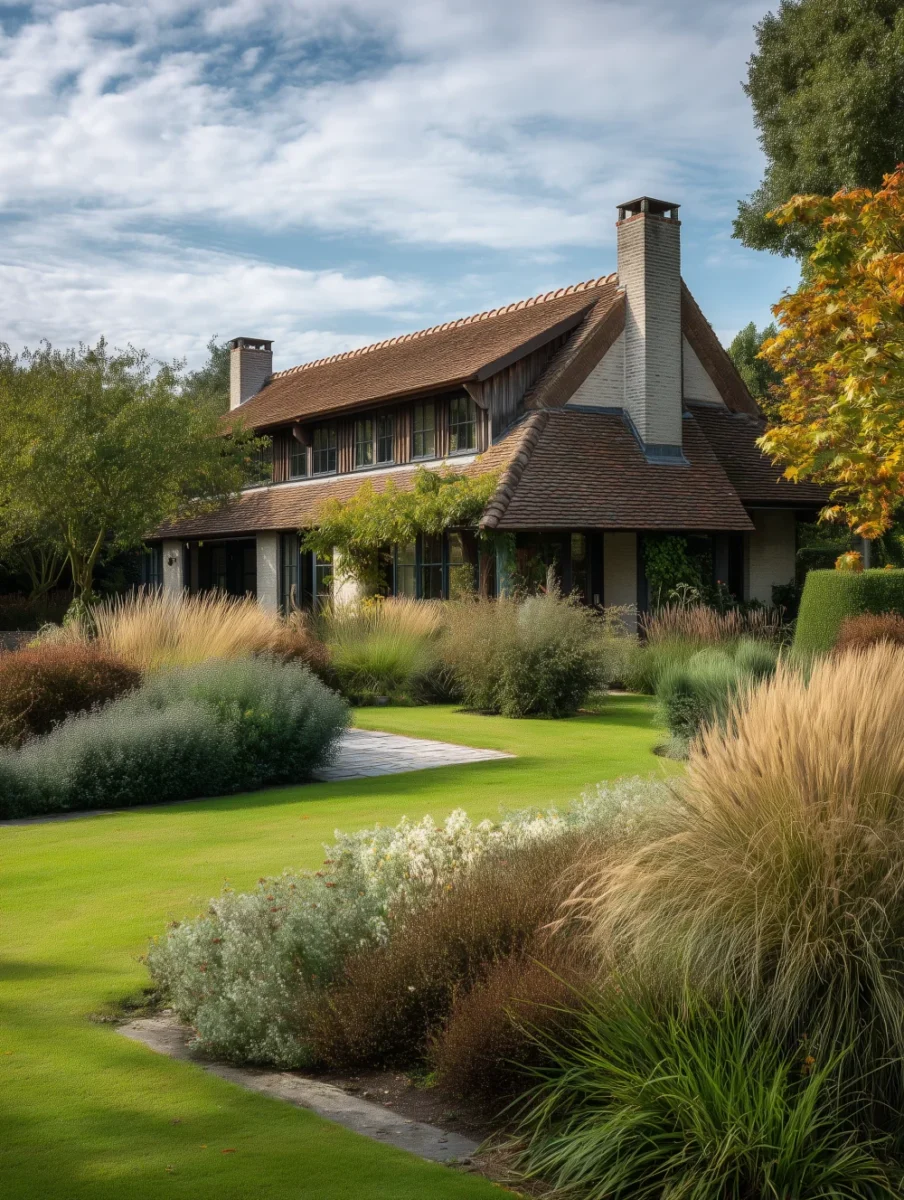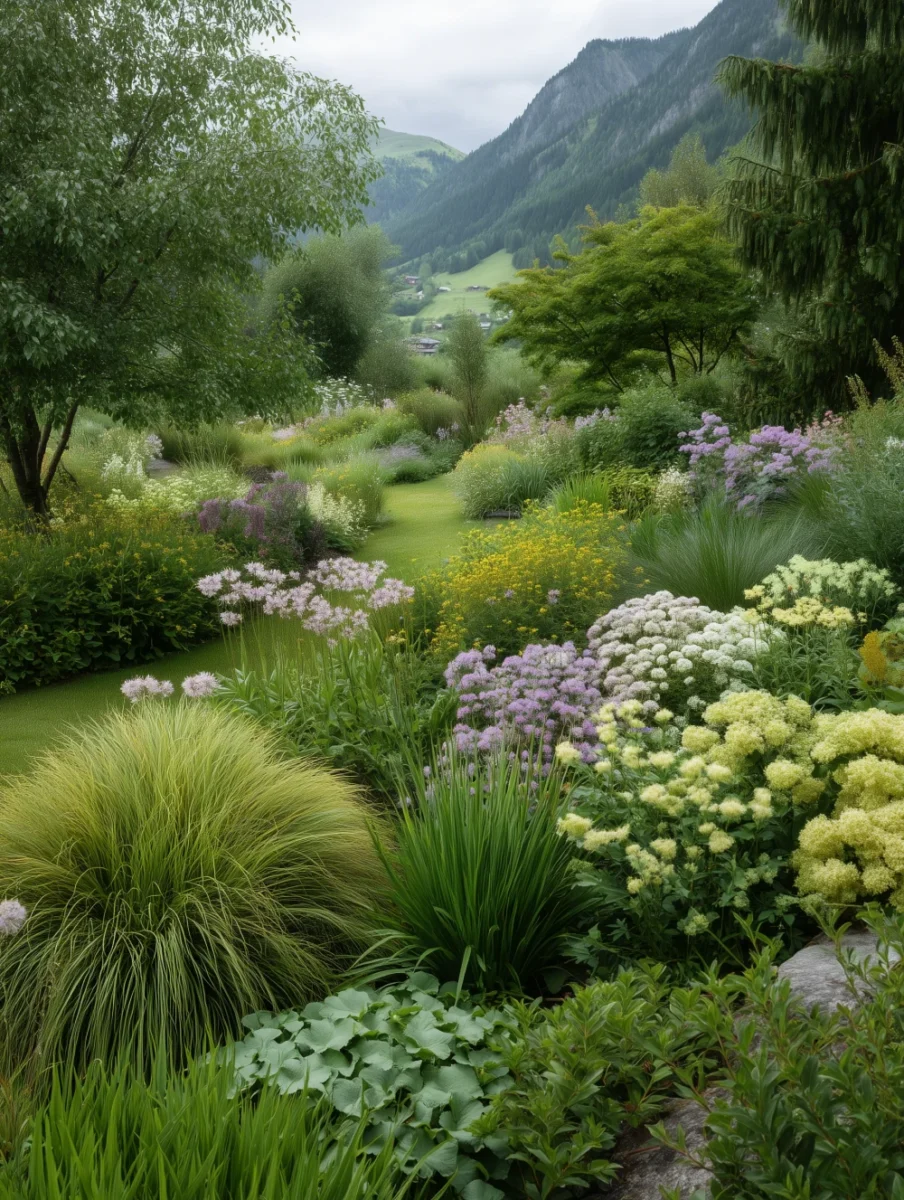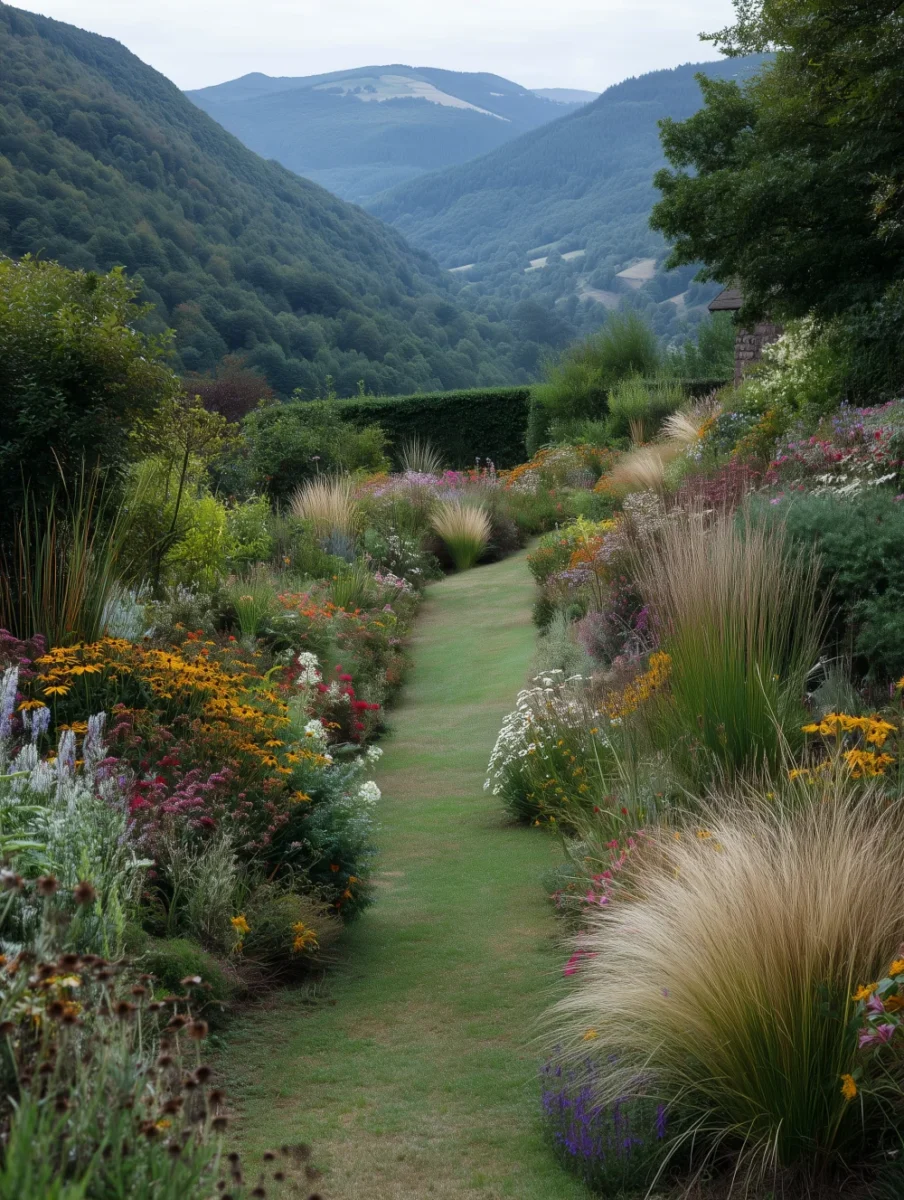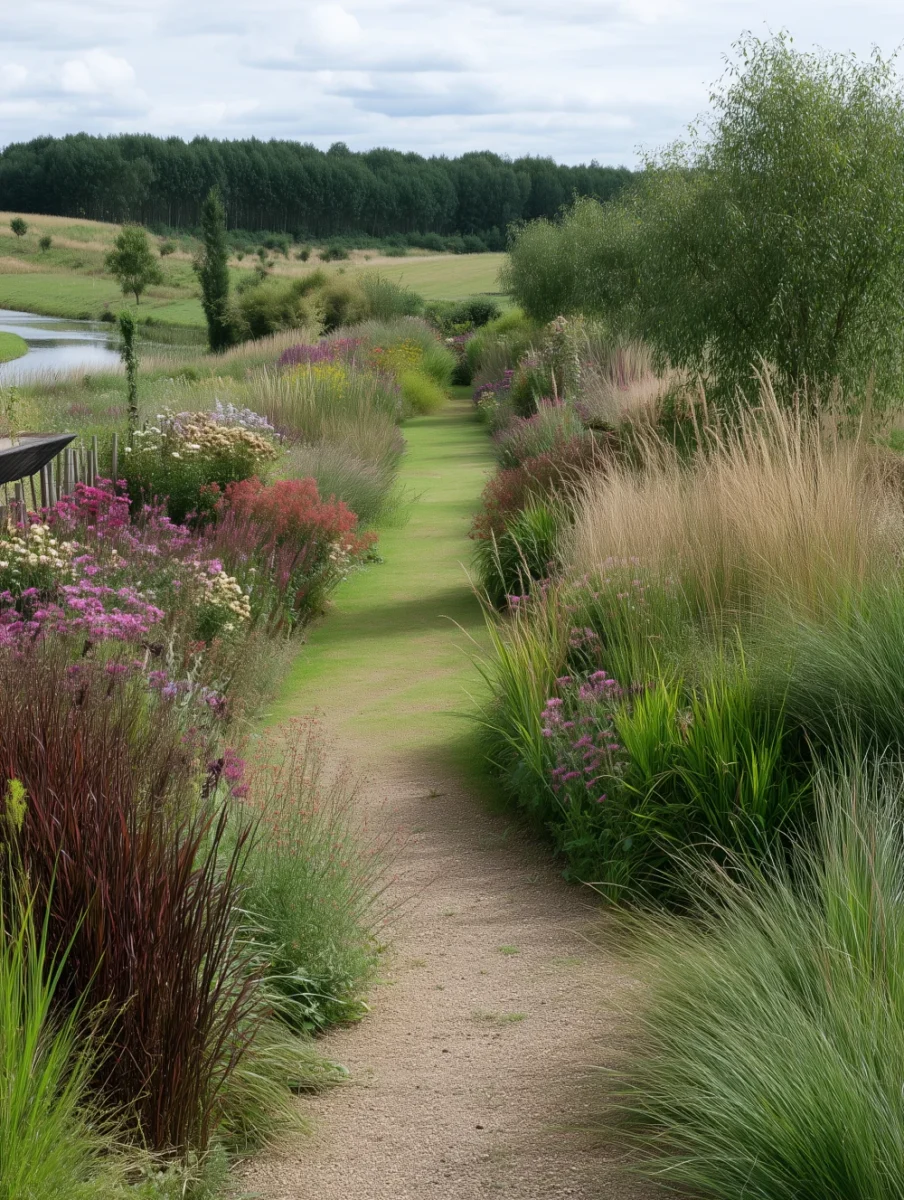
As gardeners, we love visiting and viewing other gardens and we spend many hours dreaming about and visualing what our perfect gardens might look like. Or, at least I do.
Below are some of the gardens I have been dreaming up with the help of AI.
The theme is is the modern perennial garden, inspired by Piet Oudolf and Noel Kingsbury. This kind of garden is characterised by a naturalistic style of planting, incorporating lots of grasses and a variety of colours and textures. You can see what it looks like above at a large scale in the public planting by Oudolf in the Lurie Garden in Chicago.
One of the most important aspects of this type of planting is that the plants are grouped in blocks. You need to be bold and plant in groups of 20 or 30 rather than groups of 3 or 5, as we typically plant.
What you can also see from the images below, is that there is a real synergy between this garden style and the modern architecture that the gardens have been coupled with. I think this has to do with the soft colours and flowing forms of the planting contrasted with the straight lines of the buildings.
This is also evident in the way that the planting works in the Lurie garden, surrounded by modern high rise buildings.
Modern patio perennial planting

I love the use of abundant planting – and a water feature – really close to the house in this image.
The tall grasses contrast with the shorter perennials, with additional height and interest provided by the narrow, shapely trees.
Modern perennial garden planting

In the picture above, we see how the curves of the border dictate the curves of the lawn, and how this curvy theme is picked up in the mounds of low blue and purple planting.
The height of the trees and the width of the main border suggest a real depth and fullness to the planting.
The whole picture of curves and soft planting complements and contrasts with the beautiful clean lines of the house.
The picture below also reflects the theme of low planting near the house, softening the lines of the building. The grassy area seems to add light and space to the scene and the large tree gives a sense of maturity to the setting.

Modern decking perennial planting

Decking, whilst utilitarian, often presents a rather sterile look adjacent to the home, which is why we often fill our decks with pots and and containers.
Here, an even better effect is achieved by setting the planting in a recessed planting space within the deck.
The other interesting feature in this design is the use of white/light planting which lifts the shady space.
Modern perennial planting for traditional country house

This garden showcases a naturalistic, prairie-style design that emphasises texture, movement, and seasonal interest. The planting layout is loose and informal, with swathes of ornamental grasses and perennials flowing together to create a sense of rhythm and cohesion across the landscape.
The dominant feature is the extensive use of grasses, such as Miscanthus, Pennisetum, and Stipa, which provide vertical structure and sway gently in the breeze, adding dynamic movement. Their warm tones — from golden buff to rich copper — contrast beautifully with the green of the manicured lawn, which acts as a calming visual anchor amid the more textured plantings.
Alongside the grasses are soft mounds of herbaceous perennials and sub-shrubs, including what appears to be Artemisia, Lavandula, and possibly Euphorbia or Achillea, chosen for their silvery or muted green foliage. These help create visual interest and contrast in leaf shape and colour. Pale flower spikes and airy seedheads enhance the naturalistic aesthetic and offer wildlife value, particularly for pollinators.
The Oudolf style garden design integrates well with the house’s rustic architecture. The planting beds are arranged in generous, sweeping drifts that echo the shape of the lawn and the house’s rooflines. A subdued, natural palette unifies the space, while the strategic placement of low evergreen shrubs provides winter structure.
Paved paths intersect the lawn, offering both access and strong sightlines through the space. The overall effect is one of calm elegance, seasonal beauty, and low-maintenance planting that thrives in full sun and well-drained soil.
Borrowing the surrounding landscape

This garden embodies a romantic, naturalistic planting style that blends seamlessly with the surrounding alpine landscape. Set against a dramatic mountain backdrop, the design uses layered planting to mimic a wildflower meadow, combining ornamental grasses with a wide array of flowering perennials.
The planting is rich in texture and colour, with masses of soft, billowing forms. Rounded clumps of ornamental grasses like Hakonechloa or Deschampsia add movement and structure, while clusters of flowering plants provide seasonal interest. Pale yellows, purples, and whites dominate the palette, with plants such as Thalictrum, Allium, Sedum, and possibly Astrantia adding frothy floral detail.
Broad-leaved groundcovers and low-growing perennials like Bergenia or Brunnera provide contrast in shape and foliage texture. The use of yellow-green flowers adds a sense of lightness and contrast against the lusher greens.
Trees and shrubs are positioned to frame views and provide shade, with species like birch (Betula) and possibly Acer offering fine foliage and structural elegance. The soft mounding forms and gentle colour transitions create a harmonious, immersive feel.
Overall, the garden reflects an ecological sensitivity, favouring pollinator-friendly species and a planting style that feels both cultivated and wild — a celebration of natural beauty in a mountainous setting.
Borrowing the view but contrasting with the landscape

This garden is designed as a richly planted, immersive border walk, set within a dramatic valley landscape. A narrow, winding grass path draws the eye through the scene, inviting exploration while providing a central axis for the abundant planting on either side.
The borders are densely filled with a vibrant mix of perennials and grasses. Key plants appear to include Rudbeckia and Echinacea, whose bright yellows and oranges lend warmth and energy. Spires of Liatris and drifts of Achillea, Veronicastrum, and Phlox add height and variety in flower form.
Ornamental grasses such as Stipa tenuissima and Calamagrostis punctuate the borders with movement and texture, their soft seed heads catching the light and contrasting beautifully with the upright flower spikes. The effect is a tapestry of colour, shape, and texture that changes with the seasons.
The planting is informal and naturalistic, echoing the surrounding hills. Tall shrubs and trees at the edges frame the view and integrate the garden into its broader setting. It’s a design that balances structure with softness, encouraging biodiversity and year-round visual interest.
New perennial planting

This garden exemplifies a modern naturalistic style, influenced by the New Perennial Movement. A gently curving path of compacted gravel runs through deep, richly planted borders, encouraging a slow and immersive garden experience. The planting merges seamlessly with the wider pastoral landscape, creating a sense of openness and flow.
The design focuses on strong seasonal interest and natural forms. Tall ornamental grasses such as Calamagrostis, Miscanthus, and Panicum are key structural elements, adding height, movement, and softness. Their seed heads catch the light and contrast with the surrounding perennials.
The borders are densely layered with plants like Eutrochium (Joe-Pye weed), Persicaria, Echinacea, and Achillea, offering a mix of purples, pinks, and yellows. Red-toned grasses like Imperata cylindrica ‘Red Baron’ provide vivid accents. Fine-textured species such as Stipa tenuissima and Sporobolus contribute to the airy, meadow-like effect.
Trees and shrubs are used sparingly but effectively, framing views and adding vertical rhythm. The planting is wildlife-friendly, low-maintenance, and designed to evolve beautifully through the seasons. It’s a landscape that feels both designed and naturally occurring, perfect for a modern countryside setting.
Martin Cole has been an avid plant lover and gardener for more than 20 years and loves to talk and write about gardening. In 2006 he was a finalist in the BBC Gardener of the Year competition. He is a member of the National dahlia Society.
He previously lived in London and Sydney, Australia, where he took a diploma course in Horticultural studies and is now based in North Berwick in Scotland. He founded GardeningStepbyStep.com in 2012. The website is aimed at everybody who loves plants or has been bitten by the gardening bug and wants to know more.
Gardening Step by Step has been cited by Thompson and Morgan, the UK’s largest mail order plant retailer, as a website that publishes expert gardening content.

